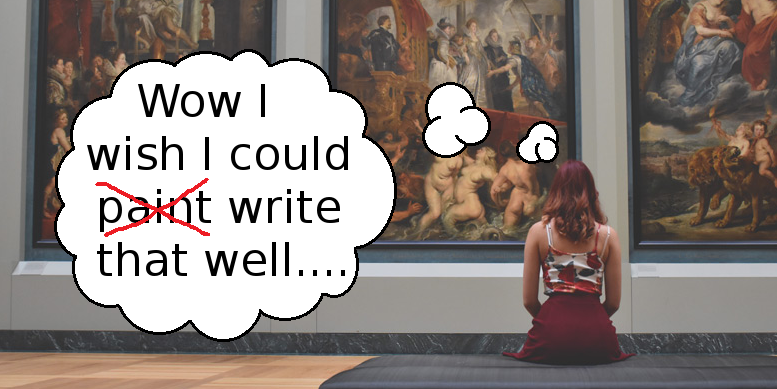Last week on Masterpiece Monday we had an installment in the series of Awesome Authors DO-ing Writing DON’Ts, and this week I’d like to continue with another addition.
When we read articles about writing online or attend writing groups and such, we’re often told NEVER to do certain things. Never tell always show, never use adverbs, never use ellipses, never use more than two adjectives at a time, etc. etc.
While many of those are usually good advice, they can be a real hindrance if stuck to all the time. I talked previously about how forcing myself to always show in my writing and never tell held me back.
This week I’d like to talk about parentheses. As writers we’re often told to never to use parentheses, unless we’re using it to cite a source in non-fiction writing.
Most of the time that makes sense. Parentheses are meant to insert extra information to the main text, so why would you use them when writing a story? If the information is relevant enough to be included, just put it in normally; if it’s not relevant enough, then just don’t include it. Right?
Not necessarily. Parentheses can do something special to fiction writing that other devices can’t: they can lift the text out of the story.
Here’s an example of what I mean, from John Green’s The Fault in Our Stars. We’ve looked at this passage before on Masterpiece Monday for a different reason, but now let’s take a look at its use of parentheses. This comes from the beginning of the book, where Hazel is describing her cancer and “depression:”
“Whenever you read a cancer booklet or website or whatever, they always list depression among the side effects of cancer. But, in fact, depression is not a side effect of cancer. Depression is a side effect of dying. (Cancer is also a side effect of dying. Almost everything is, really.)”
Those parentheses are doing a lot of work here. They feel like they’re separating part of the text, enhancing the idea like Hazel is talking just to us, like she’s pulling us aside for a private whisper.
Not only that, but because the more macabre thoughts are encased in parentheses, the parentheses make them hit the reader less intensely than they would have if they were part of the main text. Rather than making Hazel seem actually depressed, she comes off as self-depricating and humorously cynical instead.
A little bit later in the chapter, the same thing happens again, after she talks about how only kids who will die soon take the elevator:
“Michael was next. He was twelve. He had leukemia. He’d always had leukemia. He was okay. (Or so he said. He’d taken the elevator.)”
Again, without the parentheses, Hazel’s words would come off as cruel. But with the parentheses, it turns her thoughts into another private whisper that lets us see into her morbid coping mechanism.
Of course, it should be noted that after chapter one, the usage of parentheses is few and far between. That’s because after the first chapter we’ve become familiar enough with Hazel that we don’t need them anymore. Now we know who she is: she isn’t cruel, she’s just a teenage girl dealing with her crappy situation the only way she can, with humor.
The parentheses helped us get to that point of understanding her, but continuing to use them often throughout the rest of the book would probably bog down the reader. Information overload is all too easy, and it would become mentally exhausting having to pick through parenthesized and non-parenthesized text for page after page.
In the end, using parentheses is like using chocolate syrup – great in the right places in small amounts, but terrible everywhere else. A little bit on some ice cream is fantastic. A lot on ice cream and you have a bowl of regret. And even a little chocolate syrup on a steak is a disaster.
Parentheses, like chocolate syrup, is simply another option you have. Whether you’re writing or cooking, it’s important to never label any option as “off limits no matter what,” because sometimes even chocolate syrup is going to be the best tool to accomplish what you want.
(Featured image via GAHAG, edited by me)

Comments are closed.